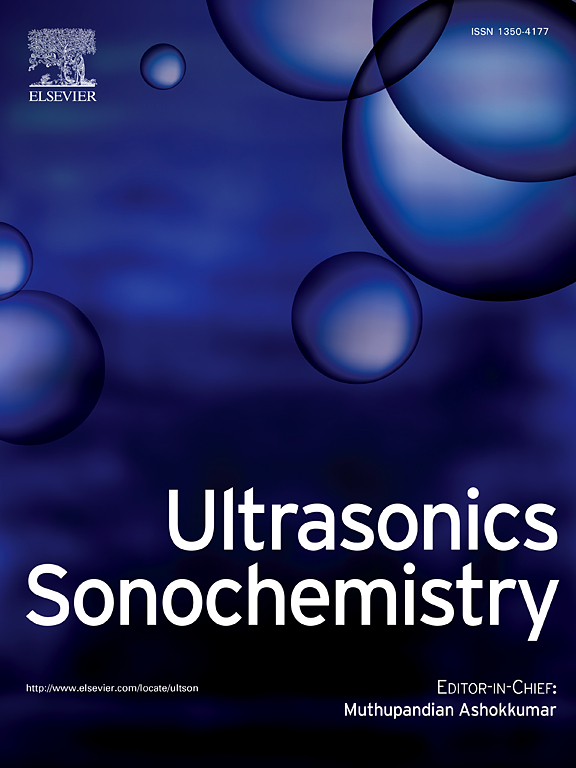Construction of nanodelivery system based on the interaction mechanism between ultrasound–treated soybean whey protein and quercetin: structure, physicochemical stability and bioaccessibility
IF 8.7
1区 化学
Q1 ACOUSTICS
引用次数: 0
Abstract
In this study, soybean whey protein (SWP) nanodelivery system was constructed through ultrasound treatment and quercetin (Que) modification. The effect of ultrasound power on the interaction mode between SWP and Que, and the formation and stability of SWP–Que nanodelivery system were investigated. Optimal ultrasound treatment (300–500 W) produced SWP–Que nanoparticles with smaller particle size, higher ζ–potential values, and more uniform dispersion. Fluorescence spectroscopy and FTIR analyses revealed that SWP primarily binds to Que through hydrophobic interactions. Ultrasound treatment induced the unfolding of the SWP structure, thereby increasing its binding affinity to Que. After 400 W sonication, the encapsulation efficiency can reach 95.63 ± 0.60 %. The SWP–Que nanoparticles protected Que from degradation under environmental stresses (heat, UV, and storage) and improved its bioaccessibility during digestion as the ultrasonic power of 400 W. This study highlights the potential of ultrasound–modified SWP nanoparticles for effective nutrient delivery.基于超声处理大豆乳清蛋白与槲皮素相互作用机理的纳米递送体系构建:结构、理化稳定性和生物可及性
本研究通过超声处理和槲皮素修饰,构建了大豆乳清蛋白(SWP)纳米递送体系。研究了超声功率对SWP与Que相互作用方式的影响,以及SWP - Que纳米递送体系的形成和稳定性。最佳超声处理(300-500 W)产生的SWP-Que纳米颗粒具有更小的粒径,更高的ζ电位值和更均匀的分散。荧光光谱和红外光谱分析表明,SWP主要通过疏水相互作用与Que结合。超声处理诱导SWP结构展开,从而增加其与Que的结合亲和力。经400 W超声处理后,封装效率可达95.63±0.60%。当超声功率为400 W时,SWP-Que纳米颗粒可防止Que在环境胁迫(热、紫外线和储存)下降解,并提高其在消化过程中的生物可及性。这项研究强调了超声波修饰的SWP纳米颗粒在有效营养输送方面的潜力。
本文章由计算机程序翻译,如有差异,请以英文原文为准。
求助全文
约1分钟内获得全文
求助全文
来源期刊

Ultrasonics Sonochemistry
化学-化学综合
CiteScore
15.80
自引率
11.90%
发文量
361
审稿时长
59 days
期刊介绍:
Ultrasonics Sonochemistry stands as a premier international journal dedicated to the publication of high-quality research articles primarily focusing on chemical reactions and reactors induced by ultrasonic waves, known as sonochemistry. Beyond chemical reactions, the journal also welcomes contributions related to cavitation-induced events and processing, including sonoluminescence, and the transformation of materials on chemical, physical, and biological levels.
Since its inception in 1994, Ultrasonics Sonochemistry has consistently maintained a top ranking in the "Acoustics" category, reflecting its esteemed reputation in the field. The journal publishes exceptional papers covering various areas of ultrasonics and sonochemistry. Its contributions are highly regarded by both academia and industry stakeholders, demonstrating its relevance and impact in advancing research and innovation.
 求助内容:
求助内容: 应助结果提醒方式:
应助结果提醒方式:


